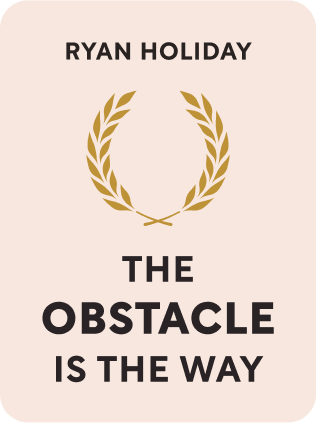

This article is an excerpt from the Shortform book guide to "The Obstacle Is The Way" by Ryan Holiday. Shortform has the world's best summaries and analyses of books you should be reading.
Like this article? Sign up for a free trial here .
What are the key principles of Stoicism philosophy? How can adopting these principles help you become calmer, stronger, and more resilient in the face of adversity?
The principles of Stoicism are underpinned by three disciplines: 1) perception, 2) action, and 3) will. With or without knowing it, most successful people have overcome their obstacles by adopting these principles.
Keep reading to learn about the key principles of Stoicism.
Stoicism: Principles
Stoicism is an ancient Greek personal ethics philosophy that teaches the development of emotional self-control and mental toughness as a means of overcoming life’s trials and tribulations. The Stoic approach to life is underpinned by three disciplines (perception, action, and will).
- Perception: how we view problems (our attitude and approach)
- Action: how we use energy and creativity to turn problems into opportunities
- Will: how our inner strength enables us to handle challenges and defeat
The three disciplines of Stoicism embody principles that apply to any challenge regardless of magnitude.
1) The Key Principles of Stoicism: Perception
Perception is how we see the world around us. Typically, we assign meaning to events—for instance, whether they’re good or bad. In contrast, Stoics view events neutrally (as they are) so they can better understand them.
Learn from crises: Rather than being distracted or misdirected by fear, view crises as learning opportunities. Observe and study them dispassionately; learn from others’ mistakes and take advantage of them.
- Because of what he learned from closely observing others’ behaviors and consequences in the Panic of 1857, John D. Rockefeller made a fortune by seizing opportunities to profit during the subsequent financial crises of 1873, 1907, and 1929.
Exercise your power: You’re never powerless; whatever the situation, you control how you perceive it and how you respond. Therefore, you have the power to transform every experience or obstacle and also yourself.
- Boxer Rubin “Hurricane” Carter spent 19 years in prison on false charges. While he had no control over this, he recognized that he still controlled his perception of the situation. He took it as an opportunity to learn, study, and work on his legal case—and he eventually left prison not only exonerated, but also a better person.
Focus on what you can change: Understand what’s within your control and what isn’t, and focus on the things you can do something about. For instance, you can’t control the economy, weather, disasters, or other people’s feelings and actions. But you can control your attitude, emotions, judgments, and responses. You control how you see and respond to obstacles.
Think differently: Your perceptions often determine what you accomplish—if an obstacle looms bigger in your mind than the goal, it will stop you. Instead of listening to naysayers, and therefore accomplishing little or nothing, think differently.
- Steve Jobs operated with a mindset that people around him referred to as his “reality distortion field,” where he believed that nearly anything he wanted to achieve was possible—and he usually was proven right.
Turn obstacles upside down: In every situation or obstacle, there’s a hidden opportunity that you can turn to your own benefit; learn to flip the obstacle upside down so you can see it.
- General Dwight D. Eisenhower broke German momentum in World War II by using an obstacle. The German Blitzkrieg strategy of making sudden attacks with overwhelming force was initially disastrous for the Allies. But Eisenhower turned the Germans’ strategy against them: He allowed them to break through Allied frontlines—then the Allies would surround the enemy force, attacking from all sides.
2) The Key Principles of Stoicism: Action
Once you’ve managed your perceptions and seen your obstacle objectively, the next step is to act. Not rashly, however—“right action” is a discipline. It has three attributes: deliberateness, boldness, and persistence. Deliberate step-by-step action breaks down obstacles.
Get going: Everyone who accomplished great things in history began by telling themselves, “Let’s go”—usually in more challenging circumstances than we face. They didn’t wait for perfect conditions. Similarly, you need to just get the ball rolling.
- Amelia Earhart wanted to be a pilot, but in the 1920s, this wasn’t an option for women. To get going, she seized a less-than-optimal opportunity. She rode along on a transatlantic flight with two male pilots and was thus the first woman to complete a flight across the ocean. Though she didn’t fly the plane, she treated the trip as a first step toward her goal.
Be persistent: The way to attack obstacles is to “persist and resist.” Approach them with calmness, patience, and determination. Realize you’re in it for the long haul and never think of quitting.
- During the Civil War, Union General Ulysses S. Grant was determined to take Vicksburg, from which Confederate forces controlled the Mississippi River. For a year, nothing he tried worked, but he continued to search patiently for a weak spot. He finally succeeded with an unconventional strategy of bypassing the city, cutting his own supply lines, and approaching from the south while living off the land.
Do what works: Often, the best way to get things done is to be a pragmatist—adapt your approach to the circumstances and do whatever works. Because action is the only way to break apart obstacles, getting results is more important than your method.
- When two fruit companies in Central America both wanted to buy the same piece of land, the smaller company won through a pragmatic approach. Since two different people claimed to own the land, the big company focused on building a legal strategy for getting it. However, the owner of the smaller company simply went to each owner and paid for the property. While he paid twice, he accomplished his goal.
Turn obstacles against themselves: Some obstacles may be insurmountable—you really can’t defeat them. But you still have another option: Get them to defeat themselves; turn their own strength against them. Alexander the Great tamed the mighty horse Bucephalus by simply mounting and hanging on until the horse tired of fighting.
3) The Key Principles of Stoicism: Will
The final discipline of Stoicism is will. The first two disciplines, perception and action, derive from the mind and body. Will comes from the heart.
Will is completely under your control. It can’t be stopped or affected by outside forces. When an obstacle or situation blocks your actions, you can exert will to transform the situation to something that benefits you.
Create an Inner Citadel: Stoics build a mental “Inner Citadel” impervious to adversity, and actively maintain and reinforce it. This means strengthening yourself mentally and physically during good times so you have the strength you need during bad times.
- Theodore Roosevelt went to great lengths to build mental and physical strength so he was ready for any challenge. As a boy, he struggled with frightening and debilitating asthma. But by working out in a gym every day for years, Roosevelt eventually managed to conquer it. His battle against asthma prepared him to endure further obstacles, including the death of his wife, political enemies, election losses, wars, and assassination attempts.
Practice acceptance: When you face a problem or situation you can’t control, the only thing you can do is accept it. Stoics refer to this as the art of acquiescence. Once you face the facts, you can very likely use the problem or challenge to your benefit.
- Thomas Jefferson had political ambitions, but he didn’t like performing publicly, and he was a terrible speaker. He accepted this, and he achieved political influence in a different and, ultimately, more effective way—through writing—and authored the Declaration of Independence.
Love whatever happens: The next step after acceptance is to love and find joy in what happens, good or bad. Setbacks and disasters in life are inevitable—you have to face up to them, so you might as well do it with joie de vivre.
- When a huge fire in 1914 destroyed 10 buildings at Thomas Edison’s New Jersey research and production facility, he reacted with enthusiasm and aplomb. Though he lost years of research records, Edison commented that the fire was “taking care of a lot of rubbish.” He treated the disaster as a fresh start, and within a year, Edison was making 10 times as much money as he had lost.
Persevere: Perseverance is having the endurance to tackle a series of obstacles without quitting until you reach your goal, even if it takes years.
- After finally winning a 10-year battle against Troy, Odysseus faced 10 more years of adversity before he could get home, including storms, a six-headed monster, captivity for seven years, and the angry god Poseidon. Odysseus got through these trials and finally made it home through courage, but most of all, with perseverance.
Have a larger purpose: When stuck in a situation you can’t control, often the best way to get through it is to ask yourself how you can at least help others, if you can’t help yourself. If you just focus on yourself and why bad things keep happening to you, you’ll stay stuck. But when you realize your ability to do some good, you’ll feel empowered.
- When U.S. Navy fighter pilot James Stockdale was shot down and captured by the North Vietnamese, he endured seven years as a prisoner of war by making it his mission to provide leadership and help the other POWs get through the ordeal.

———End of Preview———
Like what you just read? Read the rest of the world's best book summary and analysis of Ryan Holiday's "The Obstacle Is The Way" at Shortform .
Here's what you'll find in our full The Obstacle Is The Way summary :
- Why you should think of any obstacles as opportunities
- How Stoicism can show you the way to overcome challenges
- How Theodore Roosevelt's struggle with asthma prepared him for future struggles






